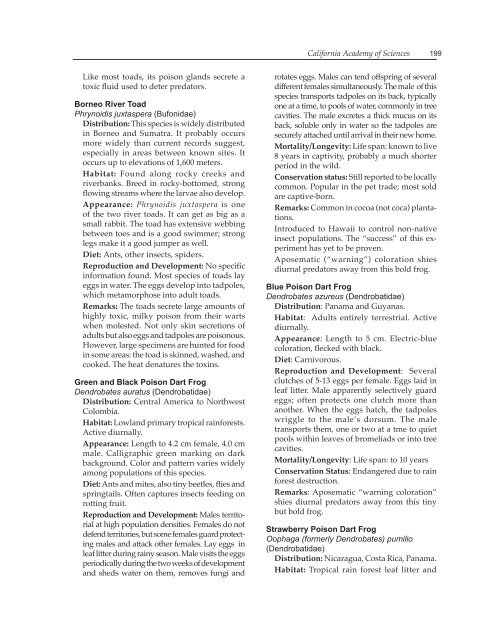THE STEINHART AQUARIUM - Gulf of Guinea Science ...
THE STEINHART AQUARIUM - Gulf of Guinea Science ...
THE STEINHART AQUARIUM - Gulf of Guinea Science ...
Create successful ePaper yourself
Turn your PDF publications into a flip-book with our unique Google optimized e-Paper software.
Like most toads, its poison glands secrete a<br />
toxic fluid used to deter predators.<br />
Borneo River Toad<br />
Phrynoidis juxtaspera (Bufonidae)<br />
Distribution: This species is widely distributed<br />
in Borneo and Sumatra. It probably occurs<br />
more widely than current records suggest,<br />
especially in areas between known sites. It<br />
occurs up to elevations <strong>of</strong> 1,600 meters.<br />
Habitat: Found along rocky creeks and<br />
riverbanks. Breed in rocky-bottomed, strong<br />
flowing streams where the larvae also develop.<br />
Appearance: Phrynoidis juxtaspera is one<br />
<strong>of</strong> the two river toads. It can get as big as a<br />
small rabbit. The toad has extensive webbing<br />
between toes and is a good swimmer; strong<br />
legs make it a good jumper as well.<br />
Diet: Ants, other insects, spiders.<br />
Reproduction and Development: No specific<br />
information found. Most species <strong>of</strong> toads lay<br />
eggs in water. The eggs develop into tadpoles,<br />
which metamorphose into adult toads.<br />
Remarks: The toads secrete large amounts <strong>of</strong><br />
highly toxic, milky poison from their warts<br />
when molested. Not only skin secretions <strong>of</strong><br />
adults but also eggs and tadpoles are poisonous.<br />
However, large specimens are hunted for food<br />
in some areas: the toad is skinned, washed, and<br />
cooked. The heat denatures the toxins.<br />
Green and Black Poison Dart Frog<br />
Dendrobates auratus (Dendrobatidae)<br />
Distribution: Central America to Northwest<br />
Colombia.<br />
Habitat: Lowland primary tropical rainforests.<br />
Active diurnally.<br />
Appearance: Length to 4.2 cm female, 4.0 cm<br />
male. Calligraphic green marking on dark<br />
background. Color and pattern varies widely<br />
among populations <strong>of</strong> this species.<br />
Diet: Ants and mites, also tiny beetles, flies and<br />
springtails. Often captures insects feeding on<br />
rotting fruit.<br />
Reproduction and Development: Males territorial<br />
at high population densities. Females do not<br />
defend territories, but some females guard protecting<br />
males and attack other females. Lay eggs in<br />
leaf litter during rainy season. Male visits the eggs<br />
periodically during the two weeks <strong>of</strong> development<br />
and sheds water on them, removes fungi and<br />
California Academy <strong>of</strong> <strong>Science</strong>s<br />
199<br />
rotates eggs. Males can tend <strong>of</strong>fspring <strong>of</strong> several<br />
different females simultaneously. The male <strong>of</strong> this<br />
species transports tadpoles on its back, typically<br />
one at a time, to pools <strong>of</strong> water, commonly in tree<br />
cavities. The male excretes a thick mucus on its<br />
back, soluble only in water so the tadpoles are<br />
securely attached until arrival in their new home.<br />
Mortality/Longevity: Life span: known to live<br />
8 years in captivity, probably a much shorter<br />
period in the wild.<br />
Conservation status: Still reported to be locally<br />
common. Popular in the pet trade; most sold<br />
are captive-born.<br />
Remarks: Common in cocoa (not coca) plantations.<br />
Introduced to Hawaii to control non-native<br />
insect populations. The “success” <strong>of</strong> this experiment<br />
has yet to be proven.<br />
Aposematic (“warning”) coloration shies<br />
diurnal predators away from this bold frog.<br />
Blue Poison Dart Frog<br />
Dendrobates azureus (Dendrobatidae)<br />
Distribution: Panama and Guyanas.<br />
Habitat: Adults entirely terrestrial. Active<br />
diurnally.<br />
Appearance: Length to 5 cm. Electric-blue<br />
coloration, flecked with black.<br />
Diet: Carnivorous.<br />
Reproduction and Development: Several<br />
clutches <strong>of</strong> 5-13 eggs per female. Eggs laid in<br />
leaf litter. Male apparently selectively guard<br />
eggs; <strong>of</strong>ten protects one clutch more than<br />
another. When the eggs hatch, the tadpoles<br />
wriggle to the male’s dorsum. The male<br />
transports them, one or two at a tme to quiet<br />
pools within leaves <strong>of</strong> bromeliads or into tree<br />
cavities.<br />
Mortality/Longevity: Life span: to 10 years<br />
Conservation Status: Endangered due to rain<br />
forest destruction.<br />
Remarks: Aposematic “warning coloration”<br />
shies diurnal predators away from this tiny<br />
but bold frog.<br />
Strawberry Poison Dart Frog<br />
Oophaga (formerly Dendrobates) pumilio<br />
(Dendrobatidae)<br />
Distribution: Nicaragua, Costa Rica, Panama.<br />
Habitat: Tropical rain forest leaf litter and


